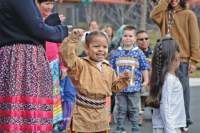Gripped by history: A one-woman mission to trace Waynesville’s early roots takes on a life of its own
 Lately, it seems Ann Melton was born in the wrong century.
Lately, it seems Ann Melton was born in the wrong century.
During the past two years, Melton has spent more time living in the late 1800s — the days when boarding houses and hitching posts lined Waynesville’s Main Street, when general stores still had butcher counters and bartering was a way of life — than the comparatively humdrum trappings of the 21st century.
Descendents rekindle Civil War tale of sheriff shot 150 years ago
 The death of Haywood County Sheriff John Phillip Noland — a murder story set against the backdrop of the American Civil War — sounds as if it belongs in the pages of Charles Frazier’s Cold Mountain.
The death of Haywood County Sheriff John Phillip Noland — a murder story set against the backdrop of the American Civil War — sounds as if it belongs in the pages of Charles Frazier’s Cold Mountain.
Uncovering the past before it’s too late: Old Smokies’ homesites slowly succumbing to time and elements
 As Don Casada veered off-trail and began bushwhacking his way over fallen logs and through overgrown shrubs along the shore of Lake Fontana, he barely glanced at the trusty GPS unit in his hand.
As Don Casada veered off-trail and began bushwhacking his way over fallen logs and through overgrown shrubs along the shore of Lake Fontana, he barely glanced at the trusty GPS unit in his hand.
He’d been this way before, many times, and knew just where he was going. Casada finally stopped at a clearing marked by a looming stone chimney, all that is left of a cabin that early Appalachian settlers had once called home.
The specter of specters awaits on Bryson City’s Ghost Walk
 By Peggy Manning • Correspondent
By Peggy Manning • Correspondent
Tim Hall relishes in the history and folklore of the mountains but also knows when a little embellishing is in order — especially when it comes to ghost stories.
Swain history, veterans will share spotlight in wall project
 Swain County is permanently etching its history in stone.
Swain County is permanently etching its history in stone.
In the next couple of months, the first of about 60 black marble panels will be installed along the wall outside the county government building and courthouse in downtown Bryson City. The panels will detail important points in Swain County’s history and also list the names of its veterans from various wars and conflicts.
Voices of the Smokies to go live in oral project
Recordings made some seven decades ago of nearly 60 men and women who lived in what became the Great Smoky Mountains National Park soon will be made publicly available online.
In 1939, a young graduate student by the name of Joseph Sargent Hall traveled through the region’s coves and hollows with an audio recorder powered off his pick-up truck battery, capturing tales of bear hunts, lessons on herbal remedies and authentic mountain tunes. He spent eight months recording the experiences of older residents and the music of young aspiring musicians. Of the 60 interviews, 17 were from Swain County and 16 were from Haywood County.
One of the mountaineers recorded by Hall was the famous Steve Woody of Cataloochee Valley, who was 86 at the time.
“That’s not me; that’s my grandfather,” Steve Woody the younger said with a laugh. “I can remember him.”
Woody owns a tape rendition of the 1939 recording Hall made of his grandfather. It is a story about a bear hunt, Woody said, and there’s also a photograph in the family album of the actual interview taking place, too.
Woody thinks it’s terrific that the old recordings soon will be made easily available.
“It’s a good thing,” he said. “I think people need to know the history of these mountains.”
When the Great Smoky Mountains National Park was created, hundreds of people living in remote Appalachian settlements were forced to move. Hall’s recordings were made just as this was happening, capturing a moment in time and way of life that was coming to an end. Woody’s grandfather was the last person to move out of Cataloochee Valley after the park was created.
The City University of New York will host the non-commercial website where the recordings will be made publicly accessible. A release date hasn’t been set — the project’s members are trying to ensure that living descendants of those recorded are given notice first that the recordings are being made public.
Michael Montgomery, a professor of English and linguistics at the University of South Carolina and a member of the project team, said that the digitized recordings are being made from tape recordings that were, in turn, made in the 1980s from the original recordings.
“They are actually quite clear for recordings made more than 70 years ago,” Montgomery said, adding that the original discs are held in safekeeping in the Library of Congress.
Copies of the recordings are currently available for people to listen to if, that is, they are willing to drive several hours into Tennessee to the Archives of Appalachia at East Tennessee State University.
A chronicler of the people
Using Civilian Conservation Corps camps for home base, Hall ventured throughout the area to record. For this work, Hall used two recorders, one that produced aluminum discs and was operated by cables hooked to a pick-up truck battery and another that made acetate discs and ran on a portable battery pack.
Montgomery said that Hall became close friends with many of the men working in the CCC camps and returned to visit them for many years after the first recordings were made. Hall died in 1992.
Luke Hyde of Bryson City, who had family members who once lived where the park was subsequently created, said he believes it will be helpful to families such as his and for park history buffs in general to have the recordings easily available via a website. In addition to the recordings, searchable texts also will be online.
“I like the general concept,” Hyde said, adding that he is well familiar with the important work done by Hall to record the people of the Smokies.
“He was fascinated by a lot of things, and he listened to people,” Hyde said. “He was one of the chroniclers of the mountain people.”
Montgomery said Hall’s interest in making this set of recordings was to record dialect. That meant he didn’t care so much what people said as long as they said something — so what’s on the recordings are such things as “women talking about herbal remedies and fellows talking about bear hunting,” Montgomery said.
Hall himself wrote about his work that, “the topics of the recordings were anything the informant wished to talk about. Men talked about their farm, their crops, their cattle, and hunting. Women liked to tell recipes or talk about their interest in weaving and quilting and the like.”
Hall also recorded the music of the day. Young musicians played country and swing and other tunes they were hearing on the radio.
“Joseph Hall recorded anything people wanted to play,” Montgomery said.
In 2010, the Great Smoky Mountains Association released “Old Time Smoky Mountain Music,” a CD with 34 of the musical selections recorded by Hall.
Montgomery said that one of Hall’s most admirable traits was his determination to stay in the background and not overshadow the men and women that he was recording.
“He thought that was the best way to counter stereotypes. He wanted mountain people to use their own voices,” Montgomery said. “His approach really was to avoid general statements and to let mountain people speak for themselves.”
Not everyone is certain the release of the recordings is a good idea.
Harley Caldwell, 75, was the last person born in Cataloochee Valley before the park was formed. He’s concerned about the privacy rights of the people who were recorded, about whether they realized that one day their stories and tales would be released publicly.
Caldwell, in fact, is involved in a similar project to Montgomery’s. The Cataloochee Oral History Project teamed with Western Carolina University to record and videotape 33 living descendents from Cataloochee. A DVD is set for release in early 2013.
“It’s a bigger project than I wanted to tackle, but I tackled it anyway,” Caldwell said.
WCU provided the equipment and is editing the interviews and preparing the DVD. Caldwell facilitated the project by rounding up the Cataloochee descendents. Caldwell said, perhaps echoing what Hall also found, that he was most surprised by “the willingness of people to talk about their past.”
One of those men interviewed was age 99, Caldwell said, adding that the man remembered historic events as if they’d occurred yesterday.
“It was the most interesting thing I’ve ever done in my life, and I’ve done a lot of exciting things,” Caldwell said of the oral history project.
One thing Caldwell and his team were careful to do was obtain signed releases from those interviewed — and he worries that, in contrast, Hall’s subjects were never cautioned that one day their voices would be heard again.
Speakers recorded by Joseph S. Hall in 1939:
Haywood County:
• Mack Caldwell, 53, Mount Sterling.
• Mack Hannah, 81, Little Cataloochee.
• Mrs. Mack (Fannie) Hannah, 73, Little Cataloochee.
• Millard Hill, 27, Saunook.
• Mark Mehaffey, Maggie.
• Bill Moore, 21, Saunook.
• Howard Moore, Saunook.
• Manuel Moore, Saunook.
• Mrs. George Palmer, 65, Cataloochee.
• Will Palmer, Cataloochee.
• Mrs. Will Palmer, 69, Cataloochee.
• Herbert Stephenson, 25, Saunook.
• Eugene Sutton, 43, Cataloochee Creek.
• Jake Sutton, 63, Cataloochee.
• Jim Sutton, 70, Cataloochee.
• Steve Woody, 86, Cataloochee.
Swain County:
• Mrs. Bill Brown, Towstring Creek.
• Dan Cable, 73, Cable Branch, Proctor.
• Aden Carver, 91, Bradley Fork, Smokemont.
• Mark Cathey, 54, Deep Creek.
• D. F. Conner, 84, Oconaluftee.
• Bert Crisp, 47, Towstring Creek.
• Zeb Crisp, 64, Hazel Creek.
• Grover Gilley, Bryson City.
• Gladys Hoyle.
• Frank Lambert, 40, Towstring Creek, Smokemont.
• Grady Mathis, 50, Smokemont.
• Al Morris, 67, Kirklands Creek.
• Rebecca Queen, 70, Cherokee.
• Docia Styles, 66, Indian Creek.
• Zilphie Sutton, 70, Chestnut Branch.
• Jake Welch, 79, Ryan Branch, Hazel Creek.
• Fate Wiggins, 79, Deep Creek.
• Mary Wiggins, Deep Creek.
WCU’s Hunter Library releases online oral history collection
A series of oral interviews with the people of Western North Carolina are now available online through Western Carolina University’s Hunter Library.
“Stories of Mountain Folk” is the first all-sound collection released by Hunter Library. The collection’s interviews cover traditions, events and life stories of regional individuals including gardeners, herbalists, farmers, musicians, artists and writers. The archive is searchable by name, place and topic.
The interviews were produced by Catch the Spirit of Appalachia, a nonprofit organization founded in 1989 by the sisters Amy Ammons Garza, an Appalachian storyteller, and Doreyl Ammons Cain, a visual artist, with the mission of preserving local memory. In September 2008, Catch the Spirit of Appalachia began “Stories of Mountain Folk” as a half-hour radio show.
Catch the Spirit of Appalachia teamed up with Hunter Library to preserve the recorded material. The online archive holds approximately half of the roughly 200 existing radio programs, with Hunter Library staff continuing to upload the backlog.
“The university has provided expertise to preserve the content, which is very different from academic creation of new intellectual content. This content was created in the community, and the library is providing a service in preserving the material,” said Anna Fariello, an associate professor in Hunter Library’s Digital Programs.
For her part, Garza is thrilled with the arrangement.
“I cannot tell you how my heart leapt when this agreement was signed,” she said. “Saving the voices of the mountain folk has been a longtime goal of Catch the Spirit of Appalachia, for listening to the mountain folk as they tell their own personal stories evokes evidence of an unmistakable wisdom and sense of place.”
The collection can be found at www.wcu.edu/library/digitalcollections/storiesofmountainfolk.
Poignant, touching, revealing: WCU collection of Civil War letters helps mark anniversary of war’s start
Next to Hunter Library at Western Carolina University is a Baptist church with a 190-year-old graveyard. George Frizzell, head of the library’s special collections, helped survey that graveyard 17 years ago.
So when Frizzell spotted a postscript to a letter in WCU’s collection of some 200 Civil War letters written by Western North Carolina soldiers and their families, the archivist described feeling an eerie chill. The names seemed familiar.
“We saw the one with the postscripts about the headstones, I thought, ‘could it possibly be?’” he said. “I walked over and found the grave, and next to it was the smaller stone to ‘Little Charley.”
In that Cullowhee Baptist Church graveyard are two Civil War-era tombstones, side by side; a large one for a Dr. Edmonston, the other one for Charley.
The story of the tombstones is told in a letter written by Maggie Edmonston, Dr. Edmonston’s wife and Charley’s mother. And it seems as relevant now, as the nation observes the 150th anniversary of the start of the Civil War, as when Maggie Edmonston wrote the words “Dear Brothers” in a poignant plea for help to her brothers-in-law. The letter is dated July 14, 1864.
“Will you please go to the marble yard in Petersburg or any yard you may see and select some nice tombstones for Dr. Edmonston’s grave?” Maggie Edmonston wrote from Webster. “Have sent off three times but failed to get any. I know you will take more interest than any buddy else please let me know if you get any so I can send you the inscription if you can get some nice ones let me know I can have them shipped to Walhalla. I want two set one small set for my baby that is all I can do for him and I never will be satisfied until I get that done.”
Dr. Edmonston was a native of Haywood County who is believed to have died here in the mountains from milk sickness after returning, weakened by illness, from the war. He was practicing medicine in Webster when he apparently drank milk poisoned with tremetol, which happens when cows graze on white snakeroot. The reason the couple’s baby died isn’t recorded, though WNC’s old cemeteries provide ample evidence of many babies in the early to mid-19th century also having died from milk sickness.
The 200 or so letters, and WCU hopes to receive even more in the years to come through donations from local families, provide an invaluable look at this region during the mid-19th century. They are being digitized and made available online. The letters demonstrate that though times have changed, human emotions have not. And although most of the Civil War battles were fought on lands far from these mountains, it touched people here as dreadfully as anywhere in the nation. As the war dragged on, it claimed more and more WNC lives, and destroyed more and more WNC families.
George Huntley, a Rutherford County native, wrote his sister Tincy on June 29, 1863, while marching into Pennsylvania as a member of the North Carolina 34th Infantry Regiment: “We are stoped to day in a Beautiful Oke grove I Cant tell whare old Lee Will Carry us tow this is One of the finest Countrys that I Ever saw.”
Three days later Huntley, a school teacher before the war, died from a wound received in the Battle of Gettysburg.
It is those types of details that bring the letters to life for Frizzell.
“The letters summon up the emotional experiences, the concerns and the hopes,” he said. “They speak so much to place, and being here.”
There are letters from Frizzell’s ancestor, M.W. Parris, telling his wife which men had been wounded and killed during the North Carolina 25th Infantry Regiment’s latest battle. The toll included a dozen or so men from Jackson County.
“I am sorry to tel that Som of our brave boys has got kild and Severl wounded in the great battle at richmond which Commenct last wensday,” Parris wrote on July 3, 1862.
Among them: Capt. Coalman’s head was shot off by a cannonball, John B. Queen fell dead as the fight started, Joseph Moody had his fingers shot off, William Cogdal (Cogdill) was wounded in the neck, Leander Hall in the leg, Harris Hooper was struck through the thigh or leg, Major Frances was badly wounded in the shoulder, W. William Beard badly wounded by a shot through his hips.
Parris adds that he believes they’ve won the battle, but describes the victory as “dearly bought” indeed.
Frizzell said Parris clearly penned the letter about the dead and wounded to the community as much as to his wife, Jane.
“These are folks they knew, and he’s trying to let all the wives know — this is how important information was shared,” Frizzell said.
Playing the part: Re-enactor honors heritage by walking in Civil War soldier’s footsteps
Jule Morrow isn’t a rebel; Lynyrd Skynyrd’s “Sweet Home Alabama” isn’t his personal mantra. He doesn’t relive the Civil War, hoping to change the outcome.
“What I honor is the courage,” said Morrow, a Civil War re-enactor whose regiment, the 25th North Carolina Infantry, plays both sides — Union and Confederate. “One thing we all have to remember is the same blood that flowed in those guys flows in us.”
Morrow is named after his ancestor Civil War Capt. Julius Welch and has ties to other prominent Haywood County residents, including the Love, Dillard and Leatherwood families. Although he has never fought in a war, Morrow has re-enacted Civil War battles throughout Georgia, Tennessee, Virginia, North Carolina and Pennsylvania for the past two decades.
About once a month, Morrow and his men in the 25th North Carolina Infantry travel up to nine hours away to participate in re-enactments, depicting both battlefield combat and camp life of the soldiers.
No matter the weather, the re-enactors sleep in canvas A-frame tents with wool blankets, eat rations of hardtack and salted beef, or if they’re lucky, build small fires to roast a chicken or cook stew. They may even scavenge the surrounding area for wild edibles.
While many battles are re-enacted during the course of a weekend, Morrow said he has slept in the field for up to five days.
In addition to reliving camp life, re-enactments showcase the war tactics of the time. Like the Romans, Civil War fighters lined up, confronting their enemy face-to-face.
Occasionally, re-enactors portray specific soldiers in specific battles — replaying the actual movements of the men on the field in real time — for the more well-known and well-documented battles where such records occur. Re-enactors are given background on the person they are depicting, including how, where and when they died or surrendered.
“I like it when you’re a particular soldier,” said Morrow, who once surrendered to Union troops while playing a member of the color guard.
The original 25th infantry back in real Civil War times was one of only a few regiments from the mountains, comprised of men from Haywood, Jackson and Macon counties, plus Buncombe, Henderson, Cherokee, Clay and Transylvania.
But at least half the time, Morrow and his men find themselves donning Union uniforms, playing the part of Union soldiers — after all, a re-enactment wouldn’t be much good without someone playing the other side.
The re-enactors’ alter ego is the 14th Iowa regiment, a Union troop with soldiers from across the western part of the U.S., making its most celebrated stand at the Battle of Shiloh, one of the bloodiest conflicts of the war.
To play both sides, the re-enactors need two sets of authentic fatigues, both grey and blue. All 25th North Carolina soldiers have in their wardrobe a black felt slouch hat, a 100 percent cotton or wool socks, a U.S. 1854 black leather belt and a U.S. 1858 Smoothside canteen, among other items.
To play the 14th Iowa regiment, men must be suited in an enlisted man’s frock, sky blue wool pants and a forage cap. Specialty haberdashers around the country make entire lines of Civil War-era clothing and accessories for re-enactors.
Twenty-five men currently belong to the regiment, down from 56 in 2002. Morrow and some of his compatriots are putting off retirement from re-enacting until the end of the Civil War’s 150th anniversary, a four-year event that promises additional pomp and circumstance.
Before too many re-enactors lay down their bayonets for the last time, Morrow said he hopes to replenish their ranks with new members, and the regiment has plenty of muskets and uniforms to loan new recruits.
For Morrow, the Civil War and its repercussion are an important part of his family history.
“Everybody’s grandma’s got the story of the Yankee that comes and takes their mule,” he said.
Morrow, who describes himself as a proud Southerner, is glad the North won the war.
“If we hadn’t lost the war, today, we would probably be like Europe; we would be 13 countries,” he said. “South Carolina would be their own little country because they can’t get on with anybody.”
A different outcome to the Civil War could also have affected future wars, he added. A divided U.S. might not have defeated Germany during WWI.
Several books and television programs have explored the world of Civil War re-enacting. But, none of them adequately represent re-enactors and many focus on the extremes, Morrow said.
In 2001, a History Channel program “The Unfinished Civil War” drew fire from re-enactors, who said the show depicted them as racists — a group of people for whom Morrow has zero tolerance.
Once during a re-enactment in Tennessee, the 24th North Carolina regiment was portraying Union troops when some Ku Klux Klan members appeared.
“These guys had the audacity to ‘boo’ me,” Morrow said. “I told one of ‘em, I said, ‘Let me tell you something.’ I said, ‘Son, when your wife sees what you’ve done to her jade satin sheets, she’s going to whoop your ass.’”
For Morrow, the Confederate flag is a symbol of Southern pride and part of his family history, but he said he understands why people find it offensive.
“We have allowed our symbol to be trashed by a bunch of ignorant pinhead klansman,” Morrow said. “What we should have done is when we saw them is go just beat the crap out of them and take their flag from them.”
See the re-enactors in action
Civil War re-enactors will be outfitted in in authentic dress, depicting camp life and battles at two upcoming events.
Appalachian Harvest Festival
When: Oct. 15, starting 11 a.m.
Where: Stecoah Valley Center outside Robbinsville
The Battle at Warm Springs
When: Nov. 4 - 6
Where: Hot Springs Resort and Spa in Hot Springs
The great routing debate: North Carolina’s battle for the Parkway
To mountain communities, the coming of the Blue Ridge Parkway 75 years ago was seen as economic salvation.
It would provided much-needed construction jobs to a region ravaged by the Depression and ultimately bring a parade of tourists seeking natural scenery.
The Parkway symbolized America’s newfound love affair with the automobile, increasingly accessible to the
middle-class yet still a novelty.
“The Parkway was conceived very much in the vein that the car would be a pleasure vehicle,” said Ted Coyle, an anthropologist at Western Carolina University. “When the Parkway was built, no one had the idea that you would take your car to go shopping. Cars were to go out and take scenic drives with.”
Today, the Parkway seems intrinsic to the mountains and carries a sense of entitlement to the millions of locals and tourists who enjoy it annually.
“It makes us feel like the Parkway was inevitable somehow, that someone thought it up wholesale, saw the
mountains and put it right out there on the land,” said Anne Whisnant, a leading Parkway historian and author at the University of North Carolina at Chapel Hill.
But the Parkway could easily have been something quite different. It was beset by social and political battles, which shaped and reshaped its route through the landscape from its conception in the early 1930s until
its eventual completion in 1987.
No sooner had President Roosevelt endorsed the Blue Ridge Parkway under the New Deal in 1933 than a raging debate broke out between North Carolina and Tennessee about which state would win the Parkway.
It had but one parameter at first: connect Shenandoah National Park with the Great Smoky Mountains. Designers soon crafted a route that would send the Parkway veering out of North Carolina and into Tennessee around Grandfather Mountain, bypassing the established tourist magnate of Asheville entirely and bringing traffic to the Smokies via Tennessee’s doorstep.
Asheville business leaders and politicians were distraught. The Depression had brought the city to its knees, and Asheville leaders saw the Parkway as a life or death proposition.
“If the Parkway were diverted from Asheville, it seemed the situation would be entirely and permanently hopeless,” Whisnant said. “The state of North Carolina got busy writing Tennessee out of the picture.”
Asheville politicians and business leaders mounted a masterful campaign to reroute the road past their city, enlisting far reaching support from the local tourist industry to the state house and governor’s mansion.
North Carolina “flung down the gauntlet” in its bid to cut Tennessee out and the “battle for the Parkway was on,” Fred Weede, director of the Asheville Chamber of Commerce at the time, wrote in his personal account of the year-long fight. Giving the Parkway to Tennessee would be an “appalling disaster,” Weede wrote in his retrospective.
The North Carolina contingency argued that God anointed them with better scenery and higher mountains. To put the Parkway anywhere else would be an affront to the Creator. But they realized that alone would not be enough to prevail.
“God had given us better scenery but man’s strategy and energy had to win the Parkway,” Weede wrote. “There were numerous tight spots encountered in shaping up a unified front. Iron hands were sometimes necessary.”
Masterful campaign
North Carolina’s campaign would not be an easy one. President Roosevelt had already endorsed the three-state route for the Parkway in a proclamation from the summer of 1933. Tennessee was well-established as the primary gateway to the Great Smoky Mountains National Park with park headquarters located there.
The Bureau of Public Roads, which would oversee eventual construction, also preferred the Tennessee route. The mountains around Asheville were the steepest and highest in the Appalachian chain, and building a road across them was seen as too expensive and challenging.
Even the landscape architects tasked with the Parkway’s design favored the lower-lying Tennessee route to provide a diversity of scenery, rather than subjecting travelers to mile upon mile of scenic but repetitive high-elevation peaks.
In an early strategy meeting held at the Asheville Chamber of Commerce, Weede impressed on the gathering the enormity of their attempt to turn the tide.
“I asserted we should face the fact we were licked before we began. But as dedicated citizens we should roll up our sleeves and fight,” Weede recounted.
Under mounting pressure from the North Carolina delegation to at least consider its pleas, Department of Interior Secretary Harold Ickes appointed a special committee tasked with selecting a route. The two states squared off in a public showdown before that committee in February 1934. In the hearing, the dueling states had three hours to present their cases.
North Carolina arrived with a well-orchestrated pitch, including large maps and photos of the “best” route for the Parkway. While several speakers made remarks, the bulk of the presentation was deferred to Getty Browning, a top road engineer with the N.C. Highway Commission, who had emerged as an effective point man for the North Carolina route.
Realizing the hue and cry from Asheville business leaders would do little to bend the committee’s ear, Browning instead focused on what he considered more objective reasoning: the superior scenery of the high mountains around Asheville.
As a locating engineer, Browning often set out cross-country on foot, climbing rugged mountains in search of the most ideal highway routes and had personally blazed every mile of the Parkway corridor North Carolina was proposing.
“He was the man on the ground in the literal sense,” said Houck Medford, director of the Blue Ridge Parkway Foundation. “He walked the Blue Ridge Parkway boundary an untold number of times. He was certainly a man’s man, but he had these other attributes and qualities that made him successful.”
He was a well-heeled socialite — charismatic, persuasive and politically savvy — yet with the mind of an engineer and persona of an outdoorsman.
Throughout the hard-fought crusade fraught with political wars and the feuding business interests, Browning kept his sights fixed on true purpose behind the Parkway.
“For Browning, it was ultimately about letting other people see the beauty of the mountains the way he saw it. There is something noble in that,” Whisnant said. “It would be useable by everyone. It would be available for free. It wouldn’t be overly controlled by commercial or monetary influences. It had something to do with our spirit.”
Following the hearing, the committee decided to take a tour of the North Carolina route. A caravan of 15 cars left Washington in March. The traveling party included many of the key players within with the National Park Service, Department of Interior and Bureau of Public Roads who would later shepherd the Parkway’s design and construction.
Since no good roads existed along much of the proposed route for the Parkway, the party planned to take side roads up and down the mountains to get a feel for the general terrain where the Parkway might pass. But the traveling party encountered a major snowstorm after crossing into North Carolina. Some gave up on the expedition in Blowing Rock. Those who ventured on to Asheville through the snow, ice and fog quite nearly didn’t make it. They later resorted to viewing the routes from the air.
Refining a strategy
As the summer of 1934 dragged on, the North Carolina contingency grew anxious. The committee tasked with recommending a route was mum.
The strategists didn’t let the downtime go to waste, however. They constantly refined their arguments and enlisted new messengers to lobby on their behalf in Washington. They met often to plan and carry out a campaign Weede later described as a “mosaic.”
“Road blocks, and they were plentiful, were approached from all angles and various solutions were weighed,” Weede wrote. “Between us — even if otherwise disposed — all cards had to put on the table face up.”
They heralded the already developed tourist industry in Asheville, ready and able to provide Parkway travelers with the type of amenities they would expect, compared to the more industrial nature of Knoxville.
They also pointed out the dearth of New Deal spending in their state. Tennessee was meanwhile the recipient of huge federal investments from the massive network of hydroelectric dams being construction by the Tennessee Valley Authority.
Newspapers played an integral role as well. The publisher of the Asheville Citizen, Charles Webb, brought the full force of his newsprint to bear for the campaign and convinced newspapers elsewhere in the state to follow his lead.
The strategists left no stone unturned, even throwing an extravagant dinner in honor of the wife of the Secretary of Interior at the Grove Park Inn when she visited Asheville.
But the centerpiece of the campaign came in the form of a red, Moroccan-leather bound photo album with a gold engraving of Roosevelt on the cover to be hand delivered to the President by an Asheville contingency. The photos showcased the scenery of the mountains around Asheville — scenery that would be left out by a Tennessee route.
The photos were culled from the collection of George Masa, a famous Japanese photographer who documented landscape scenes in Western North Carolina, while others were shot by a paid photographer escorted by Browning for the sole purpose of the project.
While much of the campaign was mounted on a shoestring due to the Depression, the nearly bankrupt Asheville Chamber of Commerce funded the production of the album, which included an inside pocket with a hand-drawn relief map of their favored route and artfully-lettered titles over each photo.
Final showdown
With still no word from the committee, Secretary of Interior Ickes announced that he would personally preside over a final hearing before selecting the route in September 1934.
A testament to the sophisticated campaign by the North Carolina delegation, a strategy was mounted to pack the hearing with their own supporters. A special train was chartered to carry their entourage to Washington. It was 18 Pullman cars long when it left Asheville with more tacked on as it traveled across the state, including a car for the governor.
A memo was read out to every car on the train instructing them to show up early for the hearing the next day. When the appointed hour arrived, nearly every chair in the room was filled by the North Carolina delegation, relegating Tennessee to standing room and the hallway outside.
Throughout the summer, Browning had bolstered his engineering case in preparation for such a final hearing, including large mounted photos offering a visual tour of the preferred route. The presentation wholly dwarfed that put on by Tennessee.
But unbeknownst to North Carolina, their opponent had an ace up its sleeve. Earlier that morning, the committee tasked with recommending a route had finally issued its decision: It unanimously favored the Tennessee route. The report was leaked to Tennessee and, although Ickes had likewise received a copy that morning, Tennessee’s delegation proudly flaunted it during the hearing.
“The announcement was a bombshell for us,” Weede wrote. “We looked at each other with considerable consternation. It was no light matter.”
To side with North Carolina, Ickes would have to rebuff his own committee.
But North Carolina had an ace of its own — one known to only a handful of key players within the campaign. It wasn’t revealed for nearly two decades and still remains a largely unknown turning point in the great routing debate.
“This ace was a very hush-hush move. No more than half a dozen individuals were in on the secret,” Weede wrote.
North Carolina’s clandestine trump card was a man named Josephus Daniels, a newspaper tycoon in the state with a summer home at Lake Junaluska near Waynesville, N.C., a town west of Asheville.
Daniels, a supporter of the North Carolina route, had personal connections that reached straight to the top. He served as the Secretary of the Navy during WWI, and his assistant secretary and right-hand man was none other than Roosevelt. Daniels was friends with Ickes to boot.
Daniels was reluctant to exploit his personal friendship with Roosevelt and Ickes, however, and throughout the agonizing spring and summer of 1934, Daniels refused to pull that lever.
“How to get him to move was our big problem,” Weede recounted.
One summer evening, Weede and Charles Webb, the publisher of the Asheville Citizen, and two other compatriots set out from Asheville to Lake Junaluska to confront what Weede called “the Daniels’ problem” head on. They arrived on the porch of Daniels’ summer home to find him already chatting with none other than Getty Browning. Daniels had clear moral objections to what the men were asking.
“Indeed our own consciences had to be stifled in urging a man to lay aside his lofty and sincere ideals of propriety and the niceties of friendship and perform an act to aid his state in its rugged battle for a great project,” Weede wrote. “It was no easy task to out argue him. But we were four against one. And we were sincere and desperate.”
They spent three hours lobbying Daniels on his porch that night, according to Weede’s account. But they left with the wording of a telegram Daniels scribbled on the back of an envelope asking Ickes for a meeting that Weede would wire the next morning.
Daniels met with both Ickes and Roosevelt that week and continued his conversations with Ickes leading up to the final showdown in September.
Two more months of waiting passed before Ickes made the announcement in November 1934 that the full route would go to North Carolina. Tennessee was livid and chastised Ickes for overruling his own advisory committee, and even appealed to Roosevelt to overturn the decision but to no avail.
The Last Front
With a route in hand, construction was imminent. But Browning’s general strokes on a map were a long way from being fixed on the landscape. The tug-of-war for the Parkway would now play out between villages and neighbors.
“You are going through a populated landscape with farms and communities. They all had different ideas about where the Parkway should go and what it should be,” Whisnant said.
While the federal government was putting up money for construction, buying rights of way fell to the states. The fabled road suddenly wasn’t so appealing to farmers along the proposed route who faced the reality of losing their land. Early descriptions of the Parkway called for a right of way of only 200 feet. But designers and engineers realized it must be five times that at least.
“If you are going to have a scenic parkway you have to preserve the scenery. They had to do that with a wide right of way,” Whisnant said. “That was a shock to landowners. It was much wider than a regular road.”
The rhetoric used when selling the Parkway wasn’t playing out like locals were led to believe. The great economic benefit seemed to evaporate with they found they couldn’t build roads and driveways from neighboring land onto the Parkway.
“Road building before that was always about giving people a way in and out,” Whisnant said.
Instead, the Parkway would have only a few appointed entrances. The Parkway was prone to trespassing and vandalism by disgruntled landowners along its length.
“A few said ‘I’m going to bulldoze a road from my property to the Parkway and there’s nothing you can do to stop me,’” Whisnant said. Others cut trees on Parkway right of way to purposely despoil roadside views.
Meanwhile, business interests were dismayed to learn they couldn’t put up billboards or signs along the route.
“It was supposed to benefit tourism but how is it going to benefit tourism if we can’t put up signs to direct people to our businesses?” Whisnant said of the sentiment. “This was sold to us as a tourism prospect but it is not.”
To make matters worse, the Parkway built its own diners and gas stations, a form of direct competition that gave tourists no compelling reason to exit the motorway.
There were also inevitable conflicts with landowners about the price being offered for rights of way. Some of the more admirable opponents were Hugh Morton of Grandfather Mountain and Harriet Clarkeson of Little Switzerland, two already developed tourism enterprises along the Parkway’s route north of Asheville. They not only understood the legal process but had political clout to take their case to the media.
Others simply lamented the passing of an era symbolized by the coming of the Parkway. Bill Watson, born in 1923, remembers when the Parkway came through the small community of Benge Gap near Boone, claiming part of his father’s farm and general store in 1938. His dad built a new one, but it wasn’t the same.
The Parkway brought rapid change to the barter-based economy that once played out inside the general store. Customers would haul in chestnuts, herbs, eggs, chickens, lumber, furs and even livestock to trade for goods from Watson’s father. Suddenly, Watson’s father found himself selling root beer to tourists.
“He much didn’t like it. He was used to being in a quiet place,” Watson said in an oral history preserved in the Parkway’s archives.
Watson moved away as a young man, but came back in the early ‘60s with a proposition for his father. He wanted to build a motel and restaurant in hopes of catering to Parkway tourists. His father was reluctant, but Watson eventually won out.
“He said that ‘Bill had lost his mind to spend his money on a motel and restaurant,’” Watson recounted. “Then so many people started coming in.”
And so it goes today. With nearly 17 million visitors every year, the Blue Ridge Parkway was indeed a prize worth fighting for.
“Certainly our forefathers, when they had the vision for the Parkway, were right on target,” said Lynn Minges, director of the N.C. Division of Tourism. “It has done exactly what they intended it to do.”
Bartram’s legacy: Scholars gather to discuss significance of 18th century botanist, writer, illustrator and philosopher
By Michael Beadle
William Bartram only came through Western North Carolina for a handful of days in the spring of 1775. The record of his travels through Cherokee country (including present-day Highlands, Franklin and the Nantahala Gorge) wouldn’t be published until more than a decade later. By that time, many of his plant discoveries were credited to others.









